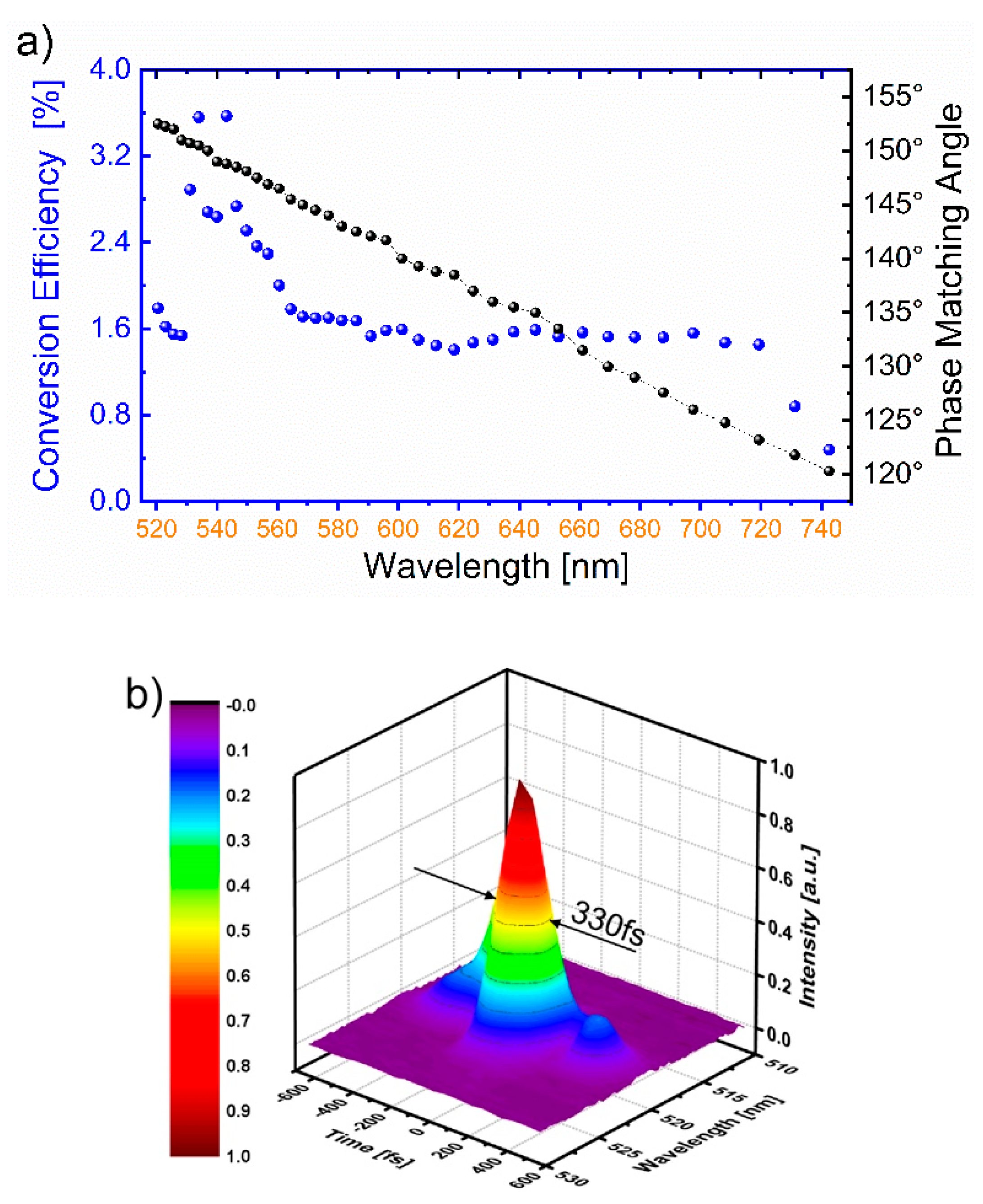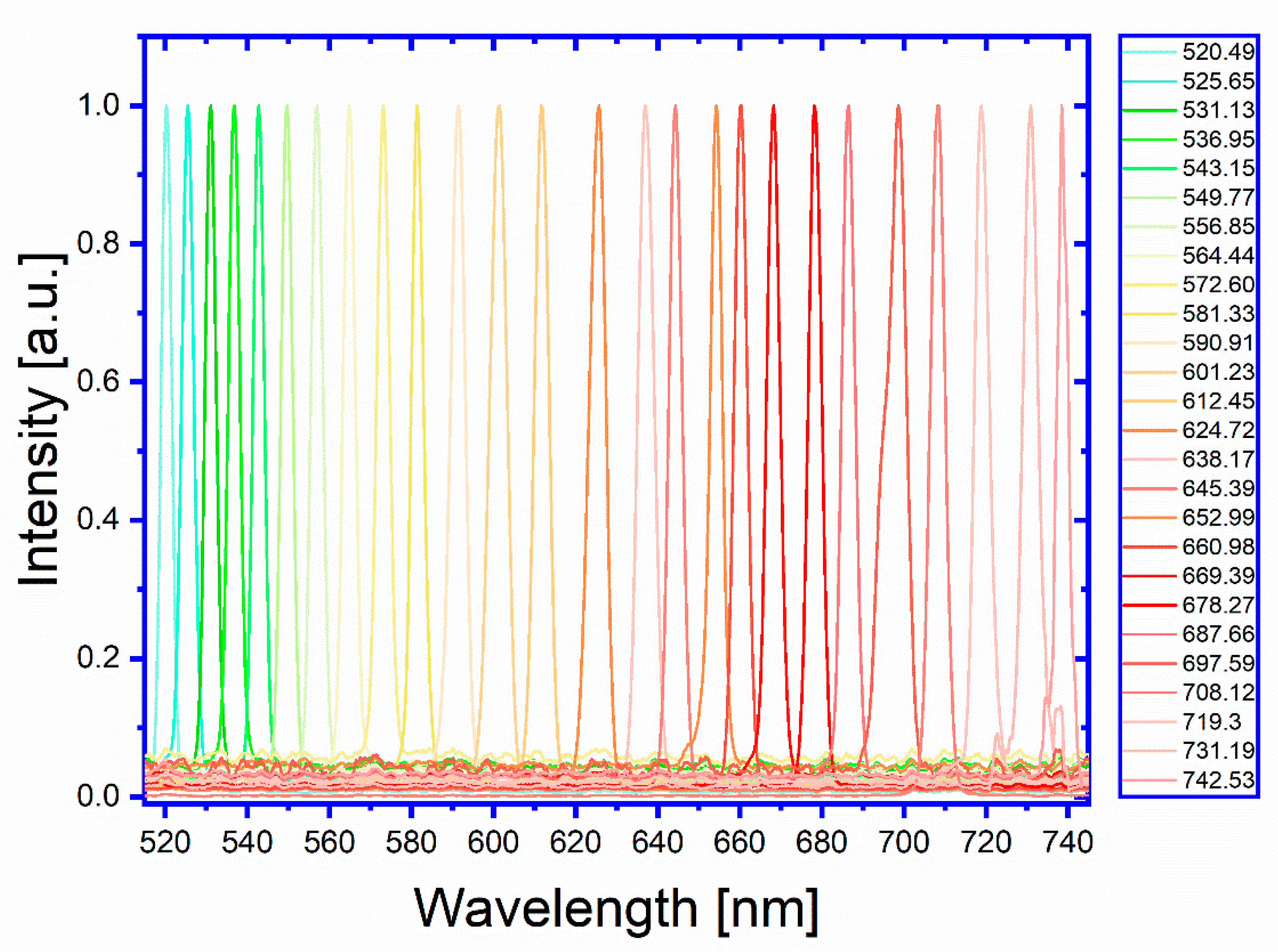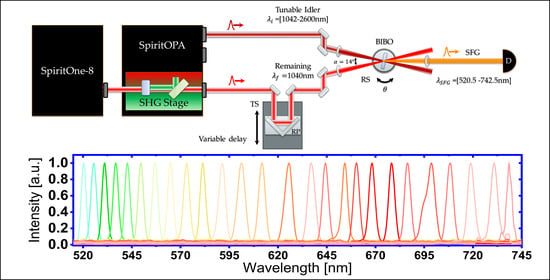Green-Yellow-Orange-Red Spectral Range with Sum-Frequency Generation Using BIBO Crystal Pumped with an Optical Parametric Amplifier
Abstract
1. Introduction
2. Materials and Methods
3. Results
4. Discussion
5. Conclusions
Author Contributions
Funding
Acknowledgments
Conflicts of Interest
References
- Keller, U. Recent developments in compact ultrafast lasers. Nature 2003, 424, 831–838. [Google Scholar] [CrossRef] [PubMed]
- Squier, J. Ultrafast Optics. Opt. Photon. News 2002, 13, 42–46. [Google Scholar] [CrossRef]
- Hoover, E.E.; Squier, J.A. Advances in multiphoton microscopy technology. Nat. Photonics 2013, 7, 93–101. [Google Scholar] [CrossRef] [PubMed]
- Phillips, K.; Gandhi, H.; Mazur, E.; Sundaram, S. Ultrafast laser processing of materials: A review. Adv. Opt. Photon. 2015, 7, 684–712. [Google Scholar] [CrossRef]
- Mottay, E. Industrial ultrafast lasers for advanced manufacturing applications. In Proceedings of the 2015 European Conference on Lasers and Electro-Optics—European Quantum Electronics Conference, paper TF_1_3, Optical Society of America, Munich, Germany, 21–25 June 2015. [Google Scholar]
- Hodgson, N.; Laha, M.; Lee, T.S.; Haloui, H.; Heming, S.; Steinkopff, A. Industrial Ultrafast Lasers—Systems, Processing Fundamentals, and Applications. In Proceedings of the Conference on Lasers and Electro-Optics, OSA Technical Digest, paper JM3E.1, Optical Society of America, Munich, Germany, 23–27 June 2019. [Google Scholar]
- Thomson, R.R.; Choudhury, D.; Ross, C. Ultrafast Laser Processes for Photonics. In Proceedings of the Optical Fiber Communication Conference (OFC) 2019, OSA Technical Digest paper Th3D.1, Optical Society of America, San Diego, CA, USA, 3–7 March 2019. [Google Scholar]
- Shen, Y. Surface properties probed by second-harmonic and sum-frequency generation. Nature 1989, 337, 519–525. [Google Scholar] [CrossRef]
- Jonkman, J.; Brown, C.M.; Wright, G.D.; Anderson, K.I.; North, A.J. Tutorial: Guidance for quantitative confocal microscopy. Nat. Protoc. 2020, 15, 1585–1611. [Google Scholar] [CrossRef]
- Erbe, A.; Nayak, S.; Chen, Y.-H.; Niu, F.; Pander, M.; Tecklenburg, S.; Toparli, C. How to Probe Structure, Kinetics, and Dynamics at Complex Interfaces in Situ and Operando by Optical Spectroscopy. In Encyclopedia of Interfacial Chemistry; Elsevier: Amsterdam, The Netherlands, 2018; pp. 199–219. [Google Scholar]
- Malcolm, H.D.; Ebrahim-Zadeh, M. Parametric Generation of Tunable Light from Continuous-Wave to Femtosecond Pulses. Science 1999, 286, 1513–1517. [Google Scholar]
- Shirakawa, A.; Mao, H.W.; Kobayashi, T. Highly efficient generation of blue-orange femtosecond pulses from intracavity-frequency-mixed optical parametric oscillator. Opt. Commun. 1996, 123, 1–3. [Google Scholar] [CrossRef]
- Nikolov, I.; Gaydardzhiev, A.; Buchvarov, I.; Tzankov, P.; Noack, F.; Petrov, V. Ultrabroadband continuum amplification in the near infrared using BiB3O6 nonlinear crystals pumped at 800 nm. Opt. Lett. 2007, 32, 3342–3344. [Google Scholar] [CrossRef]
- Giffin, S.M.; McKinnie, I.T.; Ter-Mikirtychev, V.V. Tunable visible solid-state lasers based on second-harmonic generation of LiF:F2- in potassium titanyl phosphate. Opt. Lett. 1998, 23, 192–194. [Google Scholar] [CrossRef]
- Nitiss, E.; Yakar, O.; Stroganov, A.; Brès, C.S. Highly tunable second-harmonic generation in all-optically poled silicon nitride waveguides. Opt. Lett. 2020, 45, 1958–1961. [Google Scholar] [CrossRef] [PubMed]
- Cassouret, F.; Kausas, A.; Yahia, V.; Aka, G.; Loiseau, P.; Taira, T. High peak-power near-MW laser pulses by third harmonic generation at 355 nm in Ca5(BO3)3F nonlinear single crystals. Opt. Express 2020, 28, 10524–10530. [Google Scholar] [CrossRef]
- Ebrahim-Zadeh, M. Optical Parametric Oscillators: A New Generation. In Proceedings of the Conference on Lasers and Electro-Optics 2010, OSA Technical Digest, Paper CThP1, Optical Society of America, San Jose, CA, USA, 16–21 May 2010. [Google Scholar]
- Hellwig, H.; Liebertz, J.; Bohatý, L. Linear optical properties of the monoclinic bismuth borate BiB3O6. J. Appl. Phys. 2000, 88, 240–244. [Google Scholar] [CrossRef]
- Ghotbi, M.; Ebrahim-Zadeh, M.; Majchrowski, A.; Michalski, E.; Kityk, I.V. High-average-power femtosecond pulse generation in the blue using BiB3O6. Opt. Lett. 2004, 29, 2530–2532. [Google Scholar] [CrossRef] [PubMed]
- Peltz, M.; Bartschke, J.; Borsutzky, A.; Wallenstein, R.; Vernay, S.; Salva, T.; Rytz, D. Bismuth triborate (BiB3O6) optical parametric oscillators. Appl. Phys. B 2005, 80, 55–60. [Google Scholar] [CrossRef]
- Ghotbi, M.; Esteban-Martin, A.; Ebrahim-Zadeh, M. BiB3O6 femtosecond optical parametric oscillator. Opt. Lett. 2006, 31, 3128–3130. [Google Scholar] [CrossRef] [PubMed]
- Lang, T.; Binhammer, T.; Rausch, S.; Palmer, G.; Emons, M.; Schultze, M.; Harth, A.; Morgner, U. High power ultra-widely tuneable femtosecond pulses from a non-collinear optical parametric oscillator (NOPO). Opt. Express 2012, 20, 912–917. [Google Scholar] [CrossRef]
- Manzoni, C.; Cerullo, G. Design criteria for ultrafast optical parametric amplifiers. J. Opt. 2016, 18, 103501. [Google Scholar] [CrossRef]
- Kobayashi, T.; Baltuska, A. Sub-5 fs pulse generation from a noncollinear optical parametric amplifier. Meas. Sci. Technol. 2002, 13, 1671–1682. [Google Scholar] [CrossRef]
- Mitrofanov, A.V.; Voronin, A.A.; Mitryukovskiy, S.I.; Sidorov-Biryukov, D.A.; Pugžlys, A.; Andriukaitis, G.; Flöry, T.; Stepanov, E.A.; Fedotov, A.B.; Baltuška, A.; et al. Mid-infrared-to-mid-ultraviolet supercontinuum enhanced by third-to-fifteenth odd harmonics. Opt. Lett. 2015, 40, 2068–2071. [Google Scholar] [CrossRef]
- Zhang, T.R.; Choo, H.R.; Downer, M.C. Phase and group velocity matching for second harmonic generation of femtosecond pulses. Appl. Opt. 1990, 29, 3927–3933. [Google Scholar] [CrossRef] [PubMed]
- Gobert, O.; Mennerat, G.; Maksimenka, R.; Fedorov, N.; Perdrix, M.; Guillaumet, D.; Ramond, C.; Habib, J.; Prigent, C.; Vernhet, D.; et al. Efficient broadband 400 nm noncollinear second-harmonic generation of chirped femtosecond laser pulses in BBO and LBO. Appl. Opt. 2014, 53, 2646–2655. [Google Scholar] [CrossRef] [PubMed]
- Romero, C.; de Aldana, J.R.V.; Méndez, C.; Roso, L. Non-collinear sum-frequency generation of femtosecond pulses in a micro-structured β-BaB2O4 crystal. Opt. Express 2008, 16, 18109–18117. [Google Scholar] [CrossRef] [PubMed]
- Jani, M.G.; Murray, J.T.; Petrin, R.R.; Powell, R.C.; Loiacono, D.N.; Loiacono, G.M. Pump wavelength tuning of optical parametric oscillations and frequency mixing in KTiOAsO4. Appl. Phys. Lett. 1992, 60, 2327–2329. [Google Scholar] [CrossRef]
- Ghotbi, M.; Ebrahim-Zadeh, M.; Petrov, V.; Tzankov, P.; Noack, F. Efficient 1 kHz femtosecond optical parametric amplification in BiB3O6 pumped at 800 nm. Opt. Express 2006, 14, 10621–10626. [Google Scholar] [CrossRef] [PubMed][Green Version]
- Sun, Z.; Ghotbi, M.; Ebrahim-Zadeh, M. Widely tunable picosecond optical parametric generation and amplification in BiB3O6. Opt. Express 2007, 15, 4139–4148. [Google Scholar] [CrossRef] [PubMed]
- Ghotbi, M.; Ebrahim-Zadeh, M. Optical second harmonic generation properties of BiB3O6. Opt. Express 2004, 12, 6002–6019. [Google Scholar] [CrossRef]
- Wong, T.C.; Ratner, J.; Chauhan, V.; Cohen, J.; Vaughan, P.M.; Xu, L.; Consoli, A.; Trebino, R. Simultaneously measuring two ultrashort laser pulses on a single-shot using double-blind frequency-resolved optical gating. J. Opt. Soc. Am. B 2012, 29, 1237–1244. [Google Scholar] [CrossRef]
Publisher’s Note: MDPI stays neutral with regard to jurisdictional claims in published maps and institutional affiliations. |




© 2020 by the authors. Licensee MDPI, Basel, Switzerland. This article is an open access article distributed under the terms and conditions of the Creative Commons Attribution (CC BY) license (http://creativecommons.org/licenses/by/4.0/).
Share and Cite
Quintero-Torres, R.; Domínguez-Juárez, J.L. Green-Yellow-Orange-Red Spectral Range with Sum-Frequency Generation Using BIBO Crystal Pumped with an Optical Parametric Amplifier. Photonics 2020, 7, 91. https://doi.org/10.3390/photonics7040091
Quintero-Torres R, Domínguez-Juárez JL. Green-Yellow-Orange-Red Spectral Range with Sum-Frequency Generation Using BIBO Crystal Pumped with an Optical Parametric Amplifier. Photonics. 2020; 7(4):91. https://doi.org/10.3390/photonics7040091
Chicago/Turabian StyleQuintero-Torres, Rafael, and Jorge Luis Domínguez-Juárez. 2020. "Green-Yellow-Orange-Red Spectral Range with Sum-Frequency Generation Using BIBO Crystal Pumped with an Optical Parametric Amplifier" Photonics 7, no. 4: 91. https://doi.org/10.3390/photonics7040091
APA StyleQuintero-Torres, R., & Domínguez-Juárez, J. L. (2020). Green-Yellow-Orange-Red Spectral Range with Sum-Frequency Generation Using BIBO Crystal Pumped with an Optical Parametric Amplifier. Photonics, 7(4), 91. https://doi.org/10.3390/photonics7040091





